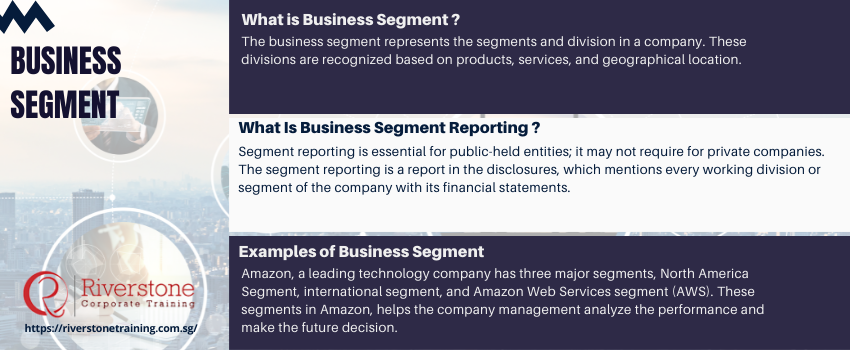
WHAT IS A BUSINESS SEGMENT?
Every company has small sections and subsections to keep track of the workflow. As the term ‘segment’ suggests, the business segment represents the segments and division in a company. These divisions are recognized based on products, services, and geographical location.
Most of the time, the management of companies divide the company into segments. These segments or subsections streamline the whole process right from production to revenue generation. If a company faces some problems, the management can look into these segments to find the eye of the problem. Also, the business segments make it easier for the company authorities to analyze the company’s performance as a whole.
The term segment explains the divisions of a company, which has its own set of operations. These divisions have distinct products and services which are separate from the company’s mainline products and services. Every particular division carries out the activities and generates financial results that contribute to the company’s overall performance, aligning with a revenue and net income comparison guide.
WHAT IS BUSINESS SEGMENT REPORTING?
Segment reporting is essential for public-held entities; it may not require for private companies.
The segment reporting is a report in the disclosures, which mentions every working division or segment of the company with its importance of financial information for decision making. The segment reporting shows a clear picture of the company’s condition and performance. In a publicly held entity, the segment reporting in the disclosure outlines the overall performance of a company in a year. It also highlights the assets and liabilities of the business, which helps management make important decisions. This process is closely tied to understanding the accounting equation in business, as it ensures that all financial data remains balanced and reliable for strategic planning. In fast-changing industries like online retail, business model innovation for e‑commerce can drive how segments are defined and reported to better reflect growth opportunities.
EXAMPLES OF BUSINESS SEGMENT:
Most of the companies have multiple segments generating huge profits. For example, say there is a company that manufactures women’s clothing. Now they have decided to produce men’s clothing as well. If they were able to sell their new product and generate revenue, it would be considered as a new business segment.
Another example would be Amazon, a leading technology company has three major segments, North America Segment, international segment, and Amazon Web Services segment (AWS). These segments in Amazon, helps the company management analyze the performance and make the future decision.
Let us take Apple Inc, one of the most renowned and recognized brands all around the globe. The company Apple Inc. designs and manufactures computers, mobiles, tablets, laptops, headphones and so much more. Now, based on these very products, the management can look into the business segments and gauge the company’s performance. Also, it helps them to improve and expand into new fields.
IFRS 8 (SFRS(I) 8) in Singapore: What Public Companies Need to Disclose About Their Business Segments
Reporting business segments is not only a good practice in the public companies in Singapore, but it is in corporate requirement under IFRS 8 (adopted locally as SFRS(I) 8). This standard helps the investors to have a clear consideration of the performance of various sections of a business in terms of product, services, and geographical levels among others. These disclosure rules are essential in terms of financial transparency and fulfillment of regulatory requirements. We will demystify the following points in SFRS(I) 8 to assist the listed entities in Singapore focus on whether their financial reports are able to give a meaningful information on their various operations and sources of income.
Reporting business segments is not only a good practice for public companies in Singapore—it is a corporate requirement under IFRS 8 (adopted locally as SFRS(I) 8). This standard ensures that investors gain a clear understanding of the performance of various sections of a business in terms of products, services, and geographical areas. These disclosure rules are essential for financial transparency and fulfilling regulatory obligations. For professionals responsible for compliance, taking a regulatory compliance course Singapore professionals trust can provide deeper insight into how SFRS(I) 8 requirements impact financial disclosures. This article will demystify the key points of SFRS(I) 8, helping listed entities in Singapore assess whether their financial reports provide meaningful information on business operations and income sources.
The Way Singapore SMEs Can Enjoy Business Segmentation
Do you think it is only the multinationals that can do business segmentation? Think again! Even the dynamic small and medium enterprises in Singapore can get huge benefits through segmentation. Just imagine being able to clearly see which line of product is actually moving you in your profitability, or which area of service you would want to give more time. With partitions segmenting your business into sensible units, it is easier to manage resources, locate areas of growth and gaps that can be utilized, and to highlight problem areas before they end up as significant issues. It is an internal strategic instrument that enables small businesses to make more informed decisions and grow at a better speed. When SMEs in Singapore embrace business segmentation, they lay the groundwork for more accurate company valuation services in Singapore—providing clearer insights into performance, value drivers, and growth potential for informed strategic decisions.
Unlocking Value: Using Business Segment Data for Smarter Investment Decisions in Singapore
Segment reporting can be considered as a goldmine to the investors and analysts in Singapore. In addition to the consolidated financial statements, analysis of the business segments of a company gives a rather detailed perspective on how that company generates revenue and makes money and what exposure it has to various markets. Does that property developer grow on the residential or the commercial projects side? Does the income of a tech company have a really diversified base on its numerous platforms? Through segment analysis, you can determine strengths that not all people see, evaluate risk in a certain company, and determine the investment you should make in Singapore-related listed companies, which will help you reveal real value. To fully leverage insights from segment reporting and uncover hidden value in Singapore-listed companies, professional business valuation training Singapore becomes essential for making smarter, data-driven investment decisions.
CONCLUSION:
The business segments are created by the companies to expand and channel their work. Every new product or service which is capable enough to generate its revenue is considered a section. The business segment also includes business segment reporting, which is an insight it the company performance. It demonstrates the whole picture of the company and helps the management make road maps for the future.


